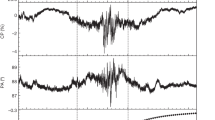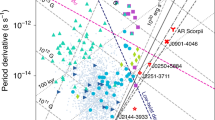Abstract
The braking index, n, of a pulsar, which describes the dependence of the braking torque on rotation frequency, is a fundamental parameter of pulsar electrodynamics. Simple theoretical arguments, based on the assumption of a constant dipolar magnetic field, predict n = 3, whereas the only previously measured value (for the Crab pulsar) is 2.515 ± 0.005. Here we present radio timing observations of the X-ray and radio pulsar, PSR1509–58, made over an approximately 2-year interval, which yield a second significant measurement of n = 2.83 ± 0.03, more than that for the Crab pulsar, but less than the canonical value of 3. Despite the large period first derivative of PSR1509–58, there is no evidence for glitches or random irregularities in the period.
This is a preview of subscription content, access via your institution
Access options
Subscribe to this journal
Receive 51 print issues and online access
$199.00 per year
only $3.90 per issue
Buy this article
- Purchase on Springer Link
- Instant access to full article PDF
Prices may be subject to local taxes which are calculated during checkout
Similar content being viewed by others
References
Pacini, F. Nature 216, 567–568 (1967).
Pacini, F. Nature 219, 145–146 (1968).
Ostriker, J. P. & Gunn, J. E. Astrophys. J. 157, 1395–1417 (1969).
Goldreich, P. & Julian, W. H. Astrophys. J. 157, 869–880 (1969).
Groth, E. J. Astrophys. J. Suppl. 29, 431–441 (1975).
Cordes, J. M. & Helfand, D. J. Astrophys. J. 239, 640–650 (1980).
Downs, G. S. Astrophys. J. 249, 687–697 (1981).
Gullahorn, G. E. & Rankin, J. M. Astrophys. J. 260, 520–537 (1982).
Manchester, R. N., Newton, L. M., Hamilton, P. A. & Goss, W. M. Mon. Not. R. astr. Soc. 202, 269–285 (1983).
Seward, F. D. & Harnden, F. R. Astrophys. J. Lett. 256, L45–L47 (1982).
Manchester, R. N., Tuohy, I. R. & D'Amico, N. Astrophys. J. Lett. 262, L31–L33 (1982).
Mills, B. Y. Proc. Astr. Soc. Aust. 4, 156–159 (1981).
Manchester, R. N. & Taylor, J. H. Pulsars (Freeman, San Francisco, 1977).
Weisskopf, M. C. et al. Astrophys. J. 267, 711–712 (1983).
Rickett, B. J. A. Rev. Astr. Astrophys. 15, 479–504 (1977).
Alpar, M. A., Anderson, P. W., Pines, D. & Shaham, J. Astrophys. J. 276, 325–334 (1984).
Alpar, M. A. & Cheng, Ho. Mon. Not. R. astr. Soc. 204, 655–667 (1983).
Roberts, D. H. & Sturrock, P. A. Astrophys. J. 181, 161–180 (1973).
Michel, F. C. Astrophys. J. 158, 727–738 (1969).
Seward, F. IAU Symp. 101, 405–416 (1983).
Manchester, R. N. & Durdin, J. M. IAU Symp. 101, 421–427 (1983).
Van den Bergh, S. & Kamper, K. W. Astrophys. J. Lett. 280, L51–L54 (1984).
Seward, F.D., Harnden, F.R., Murdin, P.G. & Clark. D.H. Astrophys. J. 267, 698–710 (1983).
Author information
Authors and Affiliations
Rights and permissions
About this article
Cite this article
Manchester, R., Durdin, J. & Newton, L. A second measurement of a pulsar braking index. Nature 313, 374–376 (1985). https://doi.org/10.1038/313374a0
Received:
Accepted:
Issue Date:
DOI: https://doi.org/10.1038/313374a0
This article is cited by
-
Pulsar braking: magnetodipole vs. wind
Science China Physics, Mechanics & Astronomy (2016)
-
Recent glitches detected in the Crab pulsar
Astrophysics and Space Science (2012)
-
New phase-coherent measurements of pulsar braking indices
Astrophysics and Space Science (2007)
-
Pulsar motion effect and Geminga's high braking index
Nature (1993)
-
Dating supernova remnants
Nature (1992)
Comments
By submitting a comment you agree to abide by our Terms and Community Guidelines. If you find something abusive or that does not comply with our terms or guidelines please flag it as inappropriate.



